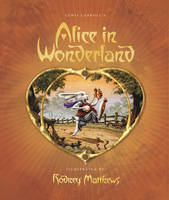LoveReading4Kids Says
The story is timeless and can be read at so many different levels, but this lavish slipcased edition is quite simply stunning and will bring to the reader a very different Wonderland - even more fantastical and a little darker too. The influence for the illustrative work was Walt Disney's 1951 animated film, a film that has left an indelible mark on Matthews. It's a visual feast and a book that can be read by people of all ages; for children it’s a wonderful underworld fantasy that will develop a passion for reading, imaginative writing and for everyone else there’s innuendo, puzzling situations that require deciphering, political machinations and bucket loads of surrealism. Plenty of food for thought and a real antidote to the modern world.
A message from John Cleese:
'Michaelangelo, Manet, Monet, Matisse, Munch, Modrian and Matthews. All my favourite artists begin with an 'M'. And so, Rodney Matthews is generally acknowledged to be among the greatest artists that have ever lived. Need I say more? Please buy this book, and all his other works, because then my immense collection of stuff will become even more valuable. Especially when he dies.'
A message from the Author:
'I feel privileged to be asked to illustrate what must be one of the most original and well known stories ever written. I can't compete with Rackham, still (in my view) the best Alice illustrator ever, or meet him head-on, but I've tried to suggest a wider visual arena for the story including a space scene and the Palace of Hearts (not mentioned by Carroll). I also move between macro and telephoto, as one would do in the best of dreams! My approach is almost as if Lewis Carroll were writing today - I would jump at the chance of illustrating him.'
LoveReading4Kids
Find This Book In
About Lewis Carroll
Lewis Carroll was born Charles Lutwidge Dodgson on January 27, 1832, the eldest son and third of eleven children born to Frances Jane Lutwidge and the Reverend Charles Dodgson. Carroll had a happy childhood. His mother was patient and gentle, and his father, despite his religious duties, tutored all his children and raised them to be good people. Carroll frequently made up games and wrote stories and poems, some of which were similar to his later published works, for his seven sisters and three brothers.
He was educated at Richmond School in Yorkshire, Rugby School and Christ Church, Oxford. Although his years at Rugby School (1846–49) were unhappy, he was recognized as a good student, and in 1850 he was admitted to further study at Christ Church, Oxford.
He graduated in 1854, and in 1855 he became mathematical lecturer at the college, where he was a somewhat eccentric and withdrawn character. This permanent appointment, which not only recognized his academic skills but also paid him a decent sum, required Carroll to take holy orders in the Anglican Church and to remain unmarried. He agreed to these requirements and was made a deacon in 1861.
Carroll loved to entertain children, and it was Alice, the young daughter of Henry George Liddell, Dean of Christ Church, who can be credited with his pinnacle inspiration. Alice Liddell remembers spending many hours with Carroll, sitting on his couch while he told fantastic tales of dream worlds. During an afternoon picnic with Alice and her two sisters, Carroll told the first iteration of what would later become Alice's Adventures in Wonderland. When Alice arrived home, she exclaimed that he must write the story down for her.
He fulfilled the small girl's request, and through a series of coincidences, the story fell into the hands of the novelist Henry Kingsley, who urged Carroll to publish it. The book Alice's Adventures in Wonderland was released in 1865. It gained steady popularity, and as a result, Carroll wrote the sequel, Through the Looking-Glass and What Alice Found There, which contained the nonsense poem classic The Jabberwocky (1871). By the time of his death, Alice had become the most popular children's book in England, and by 1932 it was one of the most popular in the world.
Unlike most of the children's books of the day, Alice and through the Looking Glass did not attempt to convey obvious moral lessons. Nor did they contain what critics have tried to insist are there—hidden meanings relating to religion or politics. They are delightful adventure stories in which a normal, healthy, clearheaded little girl reacts to the "reality" of the adult world. Their appeal to adults as well as to children lies in Alice's intelligent response to ridiculous language and action.
Carroll published several other nonsense works, including The Hunting of the Snark (1876), Sylvie and Bruno (1889), and Sylvie and Bruno Concluded (1893). He also wrote a number of pamphlets poking fun at university affairs, which appeared under a fake name or without any name at all, and he composed several works on mathematics under his true name. In 1881 Carroll gave up his lecturing to devote all of his time to writing.
Lewis Carroll died of bronchitis in his sister's home in Guildford on 14 July, 1898.
More About Lewis Carroll
